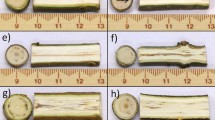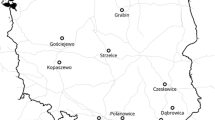Abstract
Populus deltoides (poplar) that is extensively being planted commercially in agroforestry combinations in northern India is prone to attack by a defoliating insect, Clostera cupreata. In order to evaluate the relative susceptibility/resistance of different clones and to identify the resistant ones, 80 clones of American origin were evaluated in Dehra Dun, India. The feeding potential of the pest on different clones varied significantly. The clones were grouped into six categories depending on their susceptibility as most resistant or R1 (12 clones), moderately resistant or R2 (14 clones), marginally resistant or R3 (10 clones), marginally susceptible or S1 (17 clones), moderately susceptible or S2 (18 clones) and most susceptible or S3 (nine clones). Clone ‘110120’ of Tennessee was most resistant where as Oklahoma clone ‘104’ was most susceptible to this pest. Amongst the most resistant clones (R1), only three clones, WSL-4, WSL-12 and WSL-18 (source: WIMCO Seedlings Ltd, India) were found to be superior, in terms of growth increment, as compared to the standard and most widely planted clones in northern India i.e. G-3 and G-48, and are promising clones for plantation in defoliator prone areas.
Similar content being viewed by others
References
Ahmad M (1993) Relative resistance in different clones of Populus deltoides to poplar defoliator Clostera cuperata (Lepidoptera: Notodontidae). Annals of Forestry 1: 1–12
Augustin S, Courtin C and Delplanque A (1993) Preferences of Chrysomela (Melasoma) populi L. and Chrysomela tremulae (Coleoptera: Chrysomelidae) for leuce section poplar clones. Journal of applied Entomology 115: 370–378
Augustin S, Wagner MR and Claney KM (1994) Chrysomela scripta performance on five poplar clones. Norwegian Journal of Agricultural Sciences 18: 111–117
Chaturvedi AN (1981) Poplar farming in UP. UP Forest Bulletin 45: 42
Chaturvedi AN (1992) Optimum rotation of harvest for poplars in farmlands under agroforestry. Indian Forester 118: 81–88
Chaturvedi AN and Rawat BS (1994) Poplar tree improvement program. Indian Forester 120: 110–118
Dafauce C (1976) Susceptibility of clones of black poplar to attack by Cryptorrhynchus lapathe (Coleoptera: Curculionidae). Boletin-de-la-Estacion-Central-de-Ecologia 5: 39–66
Dahms RG (1972) Techniques in the evaluation and development of host plant resistance. Journal of Environment Quality 1: 254–256
Dogra AS (1999). Productivity of poplar plantations in Punjab: A survey. In abstracts of ‘National Seminar on Poplars’, 25–27th November 1999, Forest Research Institute, Dehra Dun, India, 55 pp
FAO (1979) Poplars and willows. FAO Forestry series 10
Gao RT, Qin XX, Li JZ, Hao WQ and Wang XZ (1985) A preliminary study on the relationship between artificial defoliation of poplar trees and their growth. Scientia-Silvae – Sinicae 21: 199–205
Jodal I (1987) A study of the susceptibility of poplar clones to the attack of poplar and willow borer (Cryptorrhynchus lapathi). Processing of poplar and willow wood in Croatia. Novi Sad, 5 November 1987. Radovi Institut-Za-Tpoplarstvo 18: 188–196
Jones N and Lal P (1989) Commercial poplar planting in India under agroforestry system. Commonwealth Forestry Review 68: 19–28
Kumar D, Singh NB, Rawat GS, Srivastava S and Mohan D (1999) Improvement of Populus deltoides Bartr. Ex. Marsh. in India – I. Present status. Indian Forester 125: 245–263
Lohani DN (1979) Current status of poplar trials in Uttar Pradesh. UP Forest Bulletin 39.
Maxwell FG and Jennings PR (1980) Breeding Plants Resistant to insects. John Wiley and Sons. NY, 24 pp
Qin XX and Gae RT (1985) A preliminary investigation on the resistance of different clones of poplars to Anoplophara olabripennis (Motsch). Scientia-Silivae-Siniecs 21: 310–314
Robison DJ and Ruffa KF (1994) Characterization of hybrid poplar clones for resistance to the forest tent caterpillar. Forest Science 40: 686–714
Sharma KK (1999) Present status of poplar farming and scope for its future development in India. In abstracts of ‘National Seminar on Poplars’, 25–27th November 1999, Forest Research Institute, Dehra Dun, India, 55 pp
Singh AP and Singh KP (1995) Damage evaluation of Nodostoma waterhousie, Jacoby (Coleoptera: Chrysomelidae) on different clones, provenance's and species of poplar in Himachal Pradesh. Indian Journal of Forestry 18: 242–244
Singh P, Rawat DS, Mishra RM, Mussararat F, Prasad G and Tyagi BDS (1983) Epidemic defoliation of poplars and its control in Tarai Central Forest Division, UP. Indian Forester 9: 675–693
Singh P and Singh S (1986) Insect Pests and Diseases of Poplars. FRI and Colleges Pub, Dehra Dun, UP, 74 pp
Singh VN, Negi MS and Singh HP (1999) Demand and supply of poplar wood. In abstracts of ‘National Seminar on Poplars’, 25–27th November 1999, Forest Research Institute, Dehra Dun, India, 55 pp
WIMCO (1998) Annual research report, 1998. WIMCO Seedlings Ltd, Research and Development Center, Bagwala, Rudrapur, UP, India, 40 pp
Author information
Authors and Affiliations
Rights and permissions
About this article
Cite this article
Singh, A.P. Relative natural resistance of Populus deltoides clones against defoliator Clostera cupreata (Lepidoptera: Notodontidae) in northern India. Agroforestry Systems 49, 319–326 (2000). https://doi.org/10.1023/A:1006323004157
Issue Date:
DOI: https://doi.org/10.1023/A:1006323004157




